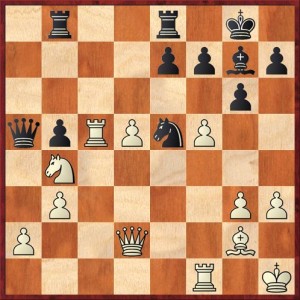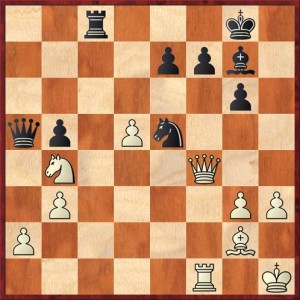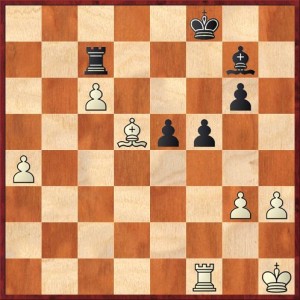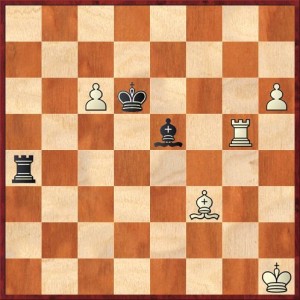Although I wrote my last post about something fictional, in fact there is real chess news to report! Today Gata Kamsky won his fourth U.S. Chess Championship in an exciting playoff against Alejandro Ramirez that went to an Armageddon game. Without wishing to minimize Kamsky’s hard-fought victory, I think the biggest story of the tournament was the performance of the young people. Even Kamsky, in his interview with Maurice Ashley afterwards, conceded as much. “They kicked our ass,” he said.
In this case, “they” refers specifically to four young people who outperformed expectations by a huge margin: Alejandro Ramirez, Conrad Holt, Kayden Troff, and Samuel Sevian. The first three scored more than 2 points above their expected scores (based on ratings).
I am most familiar with the 12-year-old Sevian, whom I have seen in many Bay Area tournaments and played against twice. His rating has shot up within the past year, but even so, he was by far the lowest-rated player in the tournament and no one would have been surprised if he had been totally outclassed. But he in fact acquitted himself very well. He lost only two games, won one and drew six for a very solid score of 4-5. That earned him an International Master norm (although I don’t think he actually needed it).
Troff (who turned 15 during the tournament) did even better, scoring 5-4 in his first U.S. Championship appearance and earning a Grandmaster norm. Ashley said that this was “Bobby Fischer territory,” although to be fair, Fischer at age 15 had already earned the GM title and was among the world’s top ten players.
Conrad Holt, age 19, was even more spectacular, going into the last round at 5½-3½ with actual chances to win the championship. Unfortunately, he suffered a devastating defeat to Timur Gareev in the last game. Holt got to a Q+N versus Q+B endgame where he had some winning chances, but he went astray and Gareev kept pressing him, even when it looked like a dead draw, until Holt finally blundered in time pressure and lost. Even with the disappointing finish, Holt took one of the five qualifying spots for the World Cup in Norway, a nice consolation prize. I have to think that this defeat to Gareev will not slow Holt down. It’s like the Golden State Warriors’ defeat against the San Antonio Spurs in the first game of their National Basketball Association playoff series: a defeat that announces better things yet to come.
And finally, there is Alejandro Ramirez. I first saw him play at the U.S. Open three years ago, which he won. I’ve been a fan ever since then, and in 2010 I correctly predicted that he would eventually move to America and become our tenth grandmaster named “Alex.” I didn’t predict, though, that he would compete so soon for the title of U.S. Champion!
In the first few rounds of the tournament it looked as if Gata Kamsky was going to run away with the title, scoring 4 wins in the first 4 games. Meanwhile, Ramirez stumbled at the start, with a draw in round 1 and a loss to Holt in round 3. But Kamsky then had one game after another where he couldn’t capitalize on superior or won positions. He played five draws in a row, while Ramirez caught up with a sizzling 5-1 finish (four wins and two draws).
Today, as I mentioned above, Kamsky and Ramirez played off for the championship title. In each of the first two games (played at a game-25 control) Kamsky got a small edge, but Ramirez defended like a virtuoso in the rook-and-pawn endgames. That took them to an Armageddon game, where Black gets draw odds but White gets a time advantage.
Ramirez “won” the Black pieces by bidding 19 minutes and 45 seconds, while Kamsky bid 20 minutes. This meant that Ramirez as Black would get 19 minutes and 45 seconds for the whole game, while Kamsky as White would get 45 minutes. They got to a Maroczy bind type of position where Ramirez fought ferociously for counterplay. Here was maybe his last real chance to save the game:
FEN: 1r2r1k1/4ppbp/6p1/qpRPnP2/1N6/1P4PP/P2Q2B1/5R1K b – – 0 1
Here Black has sacrificed a pawn to try to get out of his bind. Yasser Seirawan, who was commenting live online, could barely contain his eagerness for Black to play the move 1. … Nd3!, which the computer also recommended. After 2. Qxd3 Qxb4 White is discombobulated somewhat and in particular he loses the knight at b4, which proved to be an immensely strong piece in the game. Instead Ramirez played the more routine 1. … Rbc8, and after 2. Rxc8 Rxc8 3. fg hg Kamsky played the powerful move 4. Qf4!
FEN: 2r3k1/4ppb1/6p1/qp1Pn3/1N3Q2/1P4PP/P5B1/5R1K b – – 0 4
I just love how harmonious White’s position is. The queen at f4 both defends the knight on b4 and menaces the pawn on f7. The knight, from its unusual post on b4, defends a2 and c2 and also threatens Nc6!, deflecting Black’s knight from its defense of f7. Not only that, as Seirawan pointed out, if Black plays a plausible move like 4. … Bf6 to close the f-file, White can play 5. d6! after which White’s minor pieces become a rampaging horde — the bishop is activated and the knight can come to d5.
It’s really hard to see how Black can even fight on, but to his credit Ramirez did put up energetic resistance. He played 4. … Qc7 and now Kamsky played a super instructive move, 5. a4! You or I would have played Nc6 or maybe h4 to attack on the kingside, but Kamsky presses his advantage in every part of the board. Grandmasters accumulate every possible advantage they can before committing themselves to a move that irrevocably changes the position, like Nc6 — even if it’s a good move.
Getting increasingly desperate, Ramirez played 5. … ba 6. ba f5!? and now Kamsky finally played 7. Nc6 Nxc6 8. Qxc7 Rxc7 9. dc e5 10. Bd5+ Kf8.
FEN: 5k2/2r3b1/2P3p1/3Bpp2/P7/6PP/8/5R1K w – – 0 10
Now comes one more instructive moment. GMs Ashley and Seirawan did not like Black’s 9. … e5 at all, even though I think it’s what 99 percent of amateurs would have played, because it seems natural to activate your protected passed pawn. But Ashley and Seirawan (and Kamsky, who was actually playing the game) instantly saw that White can play 11. g4! here, which “forces” Black to play 11. … f4 and freeze his pawns on dark squares. It then becomes much more difficult for him to use the bishop for active defense.
In fact Kamsky did play 11. g4, and Ramirez refused to let his pawns become immobilized in this way. Instead he sacrificed another pawn with 11. … Ke7 12. gf gf 13. Rxf5. I think this is also instructive in its way because it shows that a grandmaster is concerned with getting the most play out of his pieces, even if it means going a couple pawns down. This probably forced Kamsky to work harder to win than he would have if Black had played the passive 11. … f4.
Nevertheless, the two pawns were too much for Ramirez to overcome, particularly because Kamsky has passed pawns on both wings. Kamsky finally got a chance to end the 2013 U.S. championship in style:
FEN: 8/8/2Pk3P/4b1R1/r7/5B2/8/7K w – – 0 22
(Space inserted in case you want to think about it.)
For a grandmaster like Kamsky this position has a degree of difficulty about 0 out of 10, but nevertheless he paused a minute to check and re-check before playing the clinching sacrifice: 23. Rxe5! Kxe5 24. c7 Black resigns. Black’s rook cannot stop both of the pawns.
Congratulations to Gata Kamsky! The victory in the Armageddon game earned him $10,000, because first prize was $30,000 and second prize was $20,000.
By the way, I’ve stated before that as a player, I hate the Armageddon playoff concept. I would be happier to have co-champions than to have the title determined in an artificially uneven match (even though the bidding procedure arguably makes it fairer). The drawback of the Armageddon format would be especially apparent if both players had bid 20 minutes. In that case, the arbiter would have flipped a coin to determine who played White and who played Black — so that in effect, the tournament could come down to a coin flip.
Nevertheless, for spectators the Armageddon playoff is great fun, because you know for sure that the title is going to be won or lost in this game. No pussy-footing around with draws. So I suspect that my one-man crusade against Armageddon chess is a losing one. For chess to succeed as a televised sport, Armageddon playoffs will probably be a necessary evil.
This brings up an interesting question: If you’re going to let the tournament be decided by an Armageddon game, why not just play the whole tournament that way? Make every game an Armageddon game. You could even have a U.S. Armageddon Chess Champion in addition to a U.S. Classical Chess Champion. Just a thought…







{ 7 comments… read them below or add one }
The bid makes the process totally fair. If both players bid 20 minutes, then both players should be happy to be Black (or be White with an opposing time of 19:59, which might as well be 20:00), so neither of them should be unhappy with either result of the coin flip. It certainly is much fairer than the White/Black disparity in a regular chess game!
Personally, I think it’s a great concept (though I am in no danger of having to participate in it myself, so that’s easy for me to say). It does create a slightly weird situation that is not the same as “real chess” (although I’d say it’s closer than Chess960), but I think it’s a ton better than playing blitz games.
There was some interesting discussion on the broadcast about the best strategy for such a game. Seirawan and Ashley both thought that Kamsky should try to delay the critical point of the game, so that the time advantage would have the maximum effect. In a way Ramirez played right into this by repeating the opening of the first game, which let White set up a Maroczy bind in which he could make Black suffer for a long time.
I guess my fundamental complaint is that Armageddon chess distorts the game. Sharp openings where Black fights for a victory go out the window, because all he needs is a draw. Black would have no incentive to play a Schliemann Variation, a Sveshnikov Variation or even a Dragon. Perhaps that doesn’t seem like a big deal, but what if you have a player whose repertoire is based on high-risk openings and based on winning with Black? It isn’t fair to him. And chess is impoverished as well.
To me one of the greatest thrills in chess is winning as Black against a strong opponent. You almost always have to get down and dirty, take some hard hits but stand back up and keep fighting. Winning with Black is a sign of chess toughness. Armageddon takes that away, or at least it takes away any reward for it. Instead, it rewards the Black player who can suck the life out of the position so that it becomes a draw.
Yeah, that is certainly a good point, though in defense of the system’s fairness, anyone at this level should probably already have a drawing-with-Black system in their repertoire. If a GM can’t play for a draw as Black, that is an outright hole in his skillset and I don’t think it’s “unfair” for that lack to put him at a disadvantage; it could put him at a disadvantage in many other contexts as well, such as last rounds or team competitions.
Hi Dana, Your readers may be interested to know that Kayden and Sam train together. They play slow time control games against each other on a weekly basis. Also, Alejandro was Kayden’s coach in Maribor Slovenia when he won the U14 World Championship last year. Lastly, Kayden has a new chess music video on Youtube which we did to try and give back to the chess community, and show chess to be as exciting as we’ve found it to be. It can be viewed here: http://youtu.be/oiXJQ0SG888 . Also Kayden’s website is kaydentroff.blogspot.com and regular updates from Kayden and on Kayden’s activites can be viewed by liking his Facebook fan page at Chess Champion Kayden Troff or twitter at chesschampkt.
Hi Dan, Thanks so much for the information! I hope that all my readers will check out Kayden’s website as well as the YouTube video, which is way beyond anything I expected. You’ll see. It’s professionally conceived, acted, and the music (classical/pops style) is awesome. Dan, if you’re still there, who came up with the idea? Was Kayden in on it from the beginning, or was he invited by the producers or the musicians?
So we’ve tried to come up with creative ideas to make chess fun for Kayden and to push that fun out to the chess populace in general. Hence, you’ll see Kayden being awarded a 1,500 lb chocolate chess set on the cable show “The Little Chocolatiers” before he won the U12 Silver Medal in the World Youth Chess Championship in Greece (on his website). This was our latest idea! We originally pitched it to “The Piano Guys” who have close to 300 million views on Youtube. They had just signed a contract with Sony Records so they were not able to do it. We then pitched it to the TLC Trio as an up and coming group, and they were excited to take it and run with it. And WOW!!! They did a top notch job on this video! They estimate that between the models, actors, professional costumers, professional make up, locations, tons of hand-work filming over the chess board and then the hundreds of hours of putting it all together; there is about 35K-40K into this production and it looks like it cost a lot more! And there is nothing out there like this! I would love to get the word out, and have everyone share this video so that chess players the world over can have something fun to cheer about – not because it’s about Kayden – but because it’s about Chess, and seeing the potential that chess has for lots and lots of enjoyment and fun!
I gambled on youth in the US Championship’s fantasy chess game. I had Holt, Bryant and Troff in there and did quite well. Not well enough to win a prize in the end but I think in the top 50 or so. It was Shulman who let me down!
{ 1 trackback }